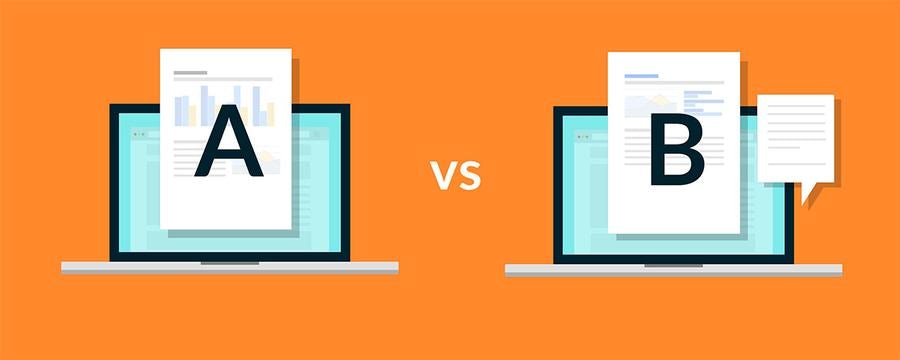A/B Testing – Maximize Your Campaigns

If you have heard inspiring success stories about businesses using A/B testing or split testing to dramatically increase their conversions, you may be curious about this type of testing and how it can benefit your business. We both use and offer A/B testing at Blue Tangerine and believe more businesses should know about this great tool, so we’re going to give you the rundown on the steps, benefits, and examples of A/B testing.
More businesses are turning to A/B testing before they make major changes to their website or advertisements because it guarantees that your changes will be effective, essentially removing the guesswork from this process. Let’s say you spend time, money, and effort changing the design of your website homepage because you think it will look better. However, you come to find out your conversions have unfortunately decreased since you made this change, and now you are frustrated because you committed to the change before testing it. A/B testing lets you know if your change will be successful or not before you officially implement it.
TYPICAL STEPS OF A/B TESTING
DECIDE WHAT TO TEST ON A GENERAL LEVEL Think about selecting pages that have the most influence in getting your site visitors what you want them to do. For example, if you want to increase the number of forms submitted, you should focus on the page where the form is located or if you are an online retailer and notice that customers leave your site after adding things to their cart, focus on the checkout page.
NARROW SELECTION DOWN TO SPECIFIC ELEMENT Now that you know what page needs improvement, you need to narrow down what will specifically be tested on that page. The original element will be your control (A) and you will need to modify or create a new variation of this element (B). So, if you want to improve the call to action on one of your webpages, you will need your existing call to action (A) and a new call to action (B). Some elements to test include:
v Copy
v Forms
v Design/layout
v Headlines
v Call to actions
Just remember that if you change more than one element in a single test, then you are no longer doing A/B testing, but rather multivariate testing, which is not covered in this post.
DESIGN YOUR TEST Develop a hypothesis – A hypothesis helps you predict what the outcome of the test will be based on your current knowledge. If you think that a more sequential navigation bar will reduce bounce rates on your landing page, then your hypothesis will look something like this: If the landing page navigation bar is changed, then we will have lower bounce rates due to a more straightforward and logical flow of information. Choose a testing platform – There are many different testing tools and platforms that you can use including ours at Blue Tangerine! We will help conduct your test and track data in an easy and timely manner with a reasonable cost.
RUN YOUR TEST Once your test is up and running, people’s interaction with your A/B elements are tracked and calculated throughout the entirety of your campaign. One of the many benefits of A/B tests is that you don’t need a ton of data and time to find out if A or B performs better.
ANALYZE TEST RESULTS No matter what testing platform you use, you will have data that must be examined to make sense of your test results. Something to keep in mind during this step is statistical significance. Normally, most experiments and test results are statistically significant if the test reaches a 95% level of significance. If you don’t feel like freshening up on your high school math skills, there are tools like Neil Patel’s A/B Testing Significance Calculator and Survey Monkey’s A/B Testing Caculator that make this process easier.
USE RESULTS TO IMPLEMENT CHANGES After making sense of your test results, it’s time to put that knowledge to use! This could mean sticking to your current call to action or maybe it’s adding a new navigation bar to your landing page. Whatever your results show, be sure to act so the information you discovered from the test isn’t wasted.
BENEFITS
Now that you know the process of A/B testing, you may be wondering what makes this testing better than using intuition to guide your changes or not making any changes at all. Some of the main benefits of A/B testing include:
v Better user engagement
v Improved content
v Increased conversions
v Decreased bounce rates
v Relatively easy to implement and analyze
v Low risk
v Encouraged by Google
v Eliminates guesswork
EXAMPLES
If you are still unconvinced of the impact A/B testing can make on your business, consider these three examples.
- CityCliq used A/B testing to test calls to actions because they wanted to increase their conversions. Their original call to action was “Businesses grow faster online!” and their variation was “Create a webpage for your business.” The variation ended up having a 90% increase in conversions compared to their original call to action!1
- Comscore, an American media analytics company, used A/B testing to increase informational social influence or social proof on a landing page for their product. They tested logos and testimonials on this landing page and by using A/B testing, they ended up increasing their lead generation by 69%. 2
- An online fashion retailer and lifestyle website, Fab, wanted to increase the number of items added to people’s carts by modifying the “Add to Cart” button. They used A/B testing to test their original button that showed a graphic of a shopping cart against a variation of the button that spelled out “Add to Cart.” Fab increased the number of items added to carts by 49% with the variation button. 3
-Kyle Rush, Optimizely